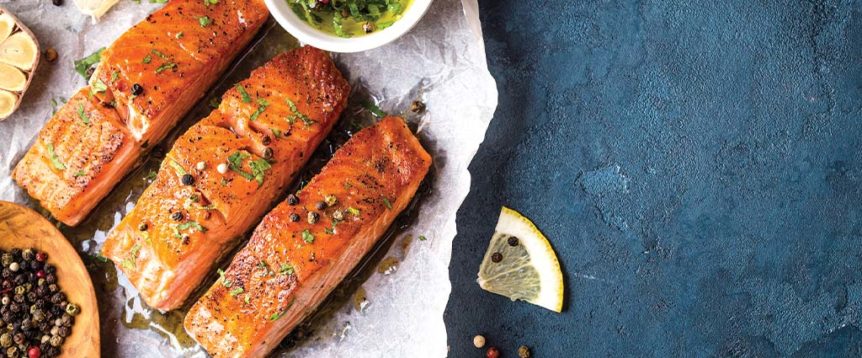Get fluent in the language of this heart-healthy fish that, come summer, is at its peak of perfection.
Headlines make it clear that salmon is good for us. It’s loaded with omega-3 fatty acids so essential for our health that the American Heart Association recommends we eat it and other fatty fish at least twice a week. What isn’t so clear is which type—Atlantic or Pacific, chinook or sockeye, wild or farmed, fresh or frozen—is best when it comes to taste, nutrition and sustainability. There isn’t a quick or easy answer, but what follows is an attempt to demystify your next trip to your grocer’s seafood case.
Fillets
The majority of fresh and frozen salmon is available in fillets and may or may not include the skin. A full fillet is one side of the fish cut lengthwise from head to tail, though it can be cut into smaller portions. Though technically boneless, a fillet of wild Pacific salmon may have scattered strays, known as pin bones, in the meat. Removing them before sale could compromise the flesh. Atlantic salmon is sold with the pin bones removed, known as PBO (short for “pin bones out”) fillets. Choose fillets that are smooth and uniform, without tears in the flesh or a strong fish odor. “Your nose is a great indicator of freshness,” says Will Martin of Seattle Fish Company. Fillets vary in thickness and length depending on the size of the fish and can be grilled, baked, broiled, pan-seared, sautéed, steamed and poached. Cook and serve fillets skin-side down and eat to the skin.
Steaks
Not to be confused with beef, a salmon steak is a cross-section cut from one side of the fish to the other, through the spine. The resulting steak is almost circular, or u-shaped, with bone in the center and skin on the outside. Unlike fillets, the thickness of steaks is consistent throughout the cut. Their thick cut makes steaks ideal for grilling, but they can also be baked, broiled, pan-seared, sautéed, steamed and poached.
Frozen
While Atlantic salmon is available year-round, wild salmon, like produce, is only available fresh during salmon season. Craving Pacific salmon in the middle of winter? Head to the frozen department. Frozen salmon is a convenient way to ensure you get your dose of omega-3s throughout the year and can sometimes be more affordable than fresh.
Quick Tip:
Not enough time to thaw your fish before dinner? No worries. Go to cookitfrozen.com for techniques to cook your frozen fillets without thawing, in as little as 15 minutes.
Canned
Canned salmon is a convenient way to eat salmon—no cooking necessary. The flavor and price will vary depending on the species used and whether it has been smoked. Canned salmon can be eaten straight out of the can, mixed with tzatziki sauce and/or yogurt for a salmon salad; served over a green salad; used in omelets, soups and chowders; or for salmon patties.
Smoked
Ranging from sweet to spicy, smoked salmon is available canned or refrigerated. The flavor varies depending on the wood used for smoking, the type of smoking (hot or cold), fish species, and any spices or flavoring. Smoked salmon is delicious on crackers or cucumber slices with cream cheese, on salads, in omelets, soups and chowders. Often referred to as smoked salmon, Nova Scotia lox—popular in New York City with bagels, cream cheese, onions and, sometimes, capers—is processed differently than smoked salmon: first cured in a brine and then cold-smoked, so the resulting product is only partially cooked.
Try this: Rub salmon with your favorite spices, and grill on untreated cedar planks (soaked in water for at least one hour) for an especially juicy salmon, infused with a light, smoky flavor.
135–140
Recommended internal temperature for salmon that is safely cooked but not dried out.
NEED INSPIRATION?
Visit these websites for more salmon recipes: Alaska Sea Food Copper River Salmon The Seafood Watch Program Marine Stewardship Council

